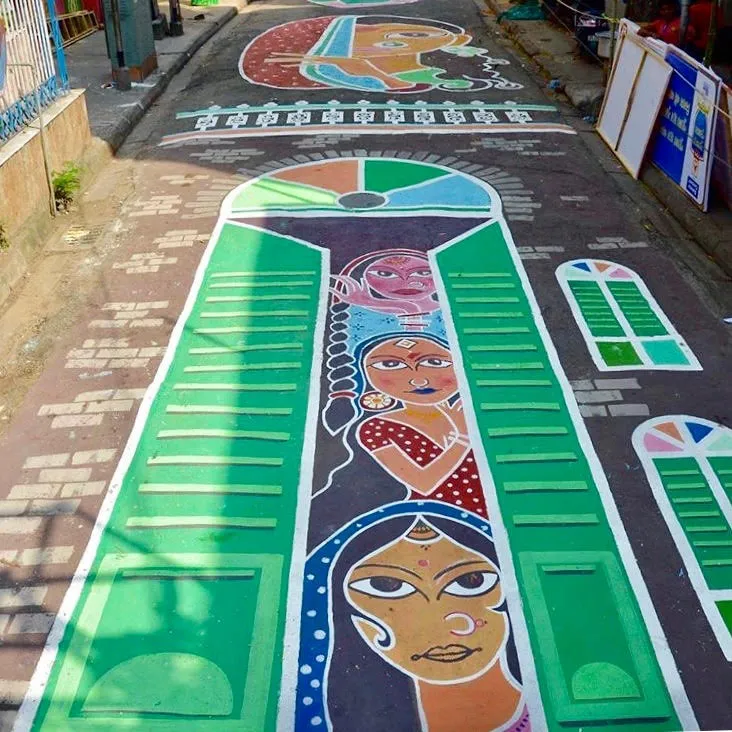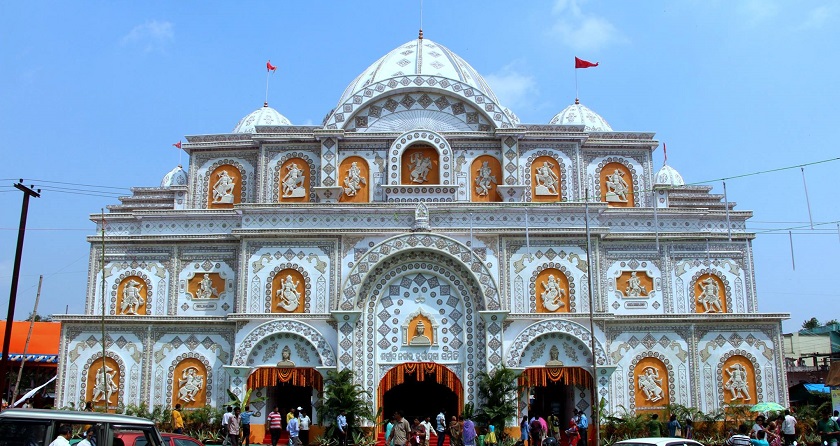Happy Vibes on Dussehra
19-10-2018
Dussehra is celebrated all over India. Some places, however, get immersed in the Puja spirit with unbelievable fervour. Whereas Kolkata is known to be the place for witnessing the grand celebration of Durgapuja, Odisha, Assam and some parts of Bihar have a long history and tradition of the worship of Maa Durga with fantastic gaiety. Here are some of the happy nuggets of Dussehra celebration from Odisha, Bengal and Assam.
1. The Façade of Historical Grandeur
Of late various Puja committees of Bhubaneswar have been putting up mandaps depicting slices of history ranging from the Chitore Fort to the Royal Albert Hall. A few pictures are attached. The mandaps draw hordes of madding (maddening!) crowd. Last evening I made a valiant attempt to go near the Devi’s idol to have a darshan. But I was swamped by a humongous crowd which appeared to be like a million to me, but in reality were at least a few thousand. I managed to offer my prayer to the Devi from far away, apologizing for not being a wrestler or a KungFu expert who could have fought his way to the vicinity of the Goddess. I made a slow, careful retreat lest I tread upon some delicate feelings. The festive mood was unmistakable. Almost all Mandaps boast of some ‘unique’ attraction. Last year, for example, the Mandap at Rasulgarh had built the Vaishno Devi shrine where one had to go through a long, winding cave to reach the Goddess. The mandap at LaxmiSagar had put up a long train and one had to enter a colourful compartment to catch a glimpse of Mahishasura Mardini Mata.



2. The Food Fest
Every Puja Mandap is a veritable food lover’s paradise! The delight is compounded by the fact that non-vegetarian dishes are allowed in the stalls. Some of the Mandaps can justifiably claim to offer the best “Kasha Mansha’, and Fish cutlets in India. And the out of the world sweets like Sandesh, Rasagolla, and Khirkadams! Yesterday, on Durga Navami, all puja mandaps offered fish Prasad to the goddess. Thousands of packets containing ‘Kaanikaa’ (a mildly sweet saffron coloured pulao made of the finest rice) and fish curry were distributed to the devotees in Cuttack, Odisha. In that city alone more than fifty quintals of fish were used on a single day in all the mandaps combined. I am not sure if it is a record of sorts for Cuttack city!
3. Awareness about the Paid Pleasure Givers
In a Kolkata street a 300 feet long Graffiti has been created by the Ahiritola Jubakbrinda to generate awareness about the plight of the paid pleasure givers of Sonagachhi, Asia’s largest red light area. It was unveiled on Monday, the 8th October, 2018. The 300-feet-long street graffiti portrayed the journey of the unfortunate women in the red-light areas with a mix of bright and bleak colours. The colours of the graffiti reflect various shades of a paid pleasure giver’s life and have brought out many untold stories of theirs. The street painting shows three women peeping from a door, bringing out many poignant stories through this form of art. Students of the Art College in Kolkata have conceptualised and drawn the stories of red light areas through their brushes and colours. On the occasion of the unveiling of the graffiti, the Working President of the Ahiritola Jubakbrinda said, “This idea of the graffiti is a human touch to the lives of these women. Our society has continued to neglect these women. But we must realise that they are also someone’s mothers and sisters. We should allow them to live a life of dignity. Ahiritola Jubakbrinda wants to make people aware about their lives through this street graffiti, which is part of our Puja theme.”

4. “Footpather Durgapuja” – A Trailblazer
In a first, children of the pavement dwellers are celebrating Durga Puja, in their own separate ‘mandap’, which is nothing but a table with a screen behind it at a small slice of pavement in Baghbazar, near Mayer Bari or the house of Shri Ramakrishna’s wife Sharada Devi. Decorations with paper flowers, ribbons add colour to the ‘mandap’ and the kids are in high spirit. Twenty children have toiled all day to make the Puja a grand success. Their Durga idol — all of one foot in height — has been made byby Surojit Sarkar and Debjit Das, students of classes VII and VI respectively, who picked up the art by observing artists at Kumartuli. The kids are thrilled that it is their own mandap and unlike in the big mandaps no one will shoo them away from the place! Devotion with Pride – that’s the way to go!

5. Hasem Ali – A Symbol of Communal Harmony in Assam
A Muslim idol-maker who dropped out of school due to poverty has become a symbol of communal harmony in Darrangand Udalguri districts of Assam.A devout Muslim, Ali is the most sought after artist for making Durga idols and erecting puja pandals in these two districts. He has had no formal training and admits to have learnt the art by observing a famous artist Kulmony Dey at his work. He started with making idols of Ravana and was persuaded to try his hand with the making of idol of the Goddess Durga. He has not looked back ever since. The artist is said to be having an unflinching faith in the equality of all religions and is happy to set an example for others. "When people say my art and I stand as a symbol of communalharmony I can’t ask for anything more. Though they are known by different names, all religions are same”.


Viewers Comments